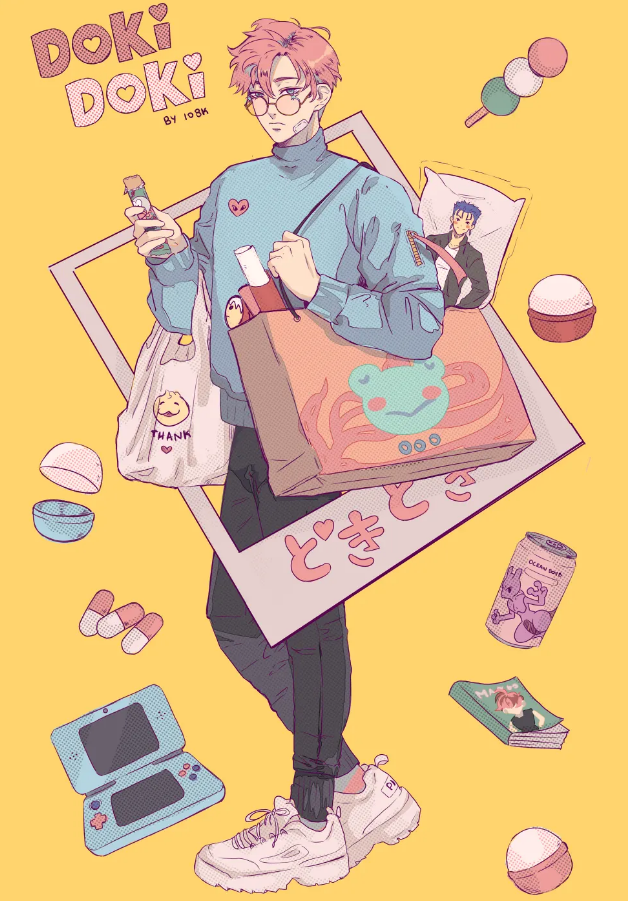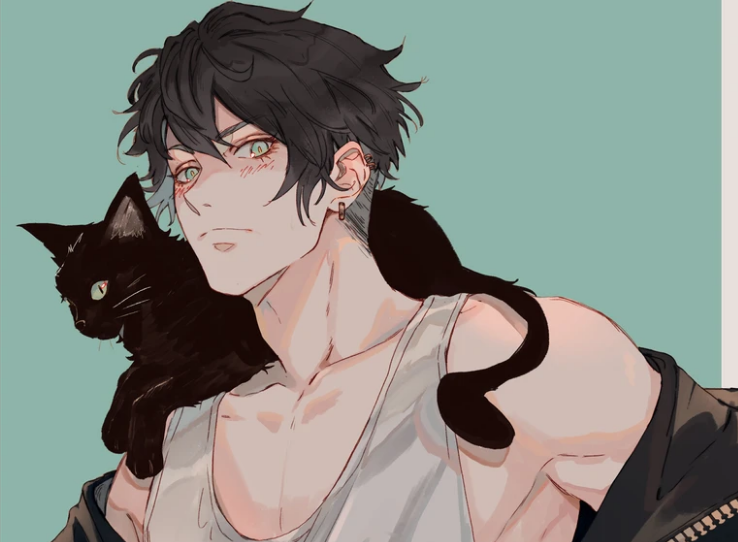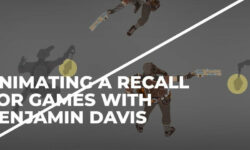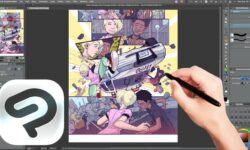Creating Unique Anime Characters with an Edge
Release date:2021
Author:108K
Skill level:Beginner
Language:English
Exercise files:Yes
This course will teach you to reference and apply everyday elements in life and use them as the foundational inspiration to create compelling characters with distinctive yet polished qualities. We’ll also explore fashion design, color theory and some other key anatomic pointers of the male character.

WHO IS THIS CLASS FOR?
This class is for both beginner and intermediate artists who strive to create original characters and want to incorporate a fresh and interesting narrative into their design.
WHAT WILL THE STUDENTS ACHIEVE?
By the end of this course, you will gain an acute understanding of the correlation of the elements that encompass an aesthetic design and thus will be able to create stimulating characters.
Chapter 1: Basic of the Basics
Presentation of Clip Studio and Its Assets
Sketch Canvas Size
Illustration DPI, Canvas Size, Color Mode
Fantastic Brushes & Where to Find Them
Chapter 2: How I Approach the Male Character
Face: Define Proportions
Male faces have certain characteristics that define them, we’ll explore them and their variations.
How to Avoid “Same Face Syndrome”
One of our biggest fears as artists, I’ll show you how I actively fight this vile monster daily.
His Body: How Does It Work Anyways?
We’ll explore the most defining traits of the male body and have a brief explanation of muscles and bones and how they do and don’t work.
Hair: Positioning and Being ‘Gravity Friendly’
Let’s learn how to draw hair while respecting the character’s head size. We’ll analyze how different hairstyles sit atop one character’s head and what to avoid.
Chapter 3: Composition and Posing
Posing and My Tricks
How to create a compelling or interesting pose without resorting to over-the-top dynamic action shots.
Composition: Making It Interesting
Who says a pose with a character just standing there is boring? Let’s make it engaging.
Let’s Draw From A Reference!
Time to put what we’ve learned to the test.
How to: ✨Expression ✨
The face is constructed by a thousands of tiny muscles, one small line in your canvas could change how the emotion is conveyed entirely. The body also plays a huge part in how we communicate our intentions in art.
Chapter 4: Sketch to lineart
It’s Time to Sketch Already!?
Plus a rough explanation of a simple sketching process.
My Sketch Process: From Blob to Form (Sketch 1 vs Sketch 2)
I’m a pretty flawed human, and so are my sketches. We’ll explore how to make the best of what we draw to achieve the desired final result.
Clean and Understand Your sketch: No Shame In Using Notes
Sometimes I draw things even I don’t understand a while later, we’ll deconstruct one of my sketches to pave the road to a clean lineart much faster.
How to Define Line Value and Points Of Interest
Where do you want the audience to focus? Let’s construct the lineart with your communicative intentions in mind.
Keep Line Consistency and Constancy
We’ll learn how to make it make sense.
What If I Turn Off the Sketch and –
When things don’t go as planned. Do you like the sketch better? Let’s understand why exactly and apply our gained knowledge to the lineart.
Lineart Color Modes I Use
I present my favorite layer modes for lineart. Sometimes, it makes all the difference.
Chapter 5: What is Color?
My Basic Color Theory™
How I pick and interpret colors.
Picking Colors
According to the mood you want to portray or how you feel like expressing yourself.
How to Compliment Colors
This is how I choose which colors I’ll use when shading and others, and why.
Light and Shadow But Fun
How does light and shadow work on a character? And how do I make it interesting choosing what to keep and what to ignore.
Rendering and Setting a Limit to the Colors
Sometimes, if you go overboard with the use of colors, the message you’re trying to convey might get lost in translation. Let’s define where that line is.
Posterize and My Other Favorite Effects
How to turn more into less? Is it shiny enough? Let’s experiment.
Color Correction Layers
Because it might look good now but does it look its best?
Chapter 6: Clothes, What The Fold?
Types of Folds and Gravity in Garment A hoodie in a hanger will look radically different on a person, depending on size, height, weight, etc. Let’s explore the possibilities.
Understanding the Different Kinds of Fabrics There are thousands of fabrics and colors, we’ll explore the ones I use the most and how they look and behave.
How Shading Works With Different Types of Clothing
Fabrics have different materiality, and that also applies to how light is reflected or absorbed in them.
Approach at Referencing in Garment
Key pointers to success at your own clothing design.
Chapter 7: Character From Everyday Inspiration
Exploring Your Interests and Building a Moodboard.
Favorite color? Aesthetic? Mascot or snack, anything goes. You’ll be able to visualize what you enjoy to better understand what inspires you and makes you want to draw.
Select and Understand your Everyday Inspiration
Be it your fortune cat, a can of that one energetic drink or a very interesting lamp. We’ll deconstruct it.
From Object to Character
I will show how to take the characteristics of an object and apply them to an OC.
Customize Them: A Small Backstory & Personality
He might be a mortician from the 1800s or a cyberpunk mutant from 2287, defining just a bit of backstory can go a long way toward garnering even more possibilities into their appearance and demeanor in the final illustration.
Applying What We’ve Learned So Far to Draft a Simple Character Sheet.
Including a couple expressions, 2 full body shots from different angles and colors.
Chapter 8: Illustration, But For Real
Using the Character We Created, Let’s Make an Illustration.
From sketch, to lineart, to rendering. The whole process (and struggles)
Post Effects.
Editing and correcting the finished illustration with mesh transform and others + a little secret layer.
Exporting Your File and Preparing for Posting or Printing.
What is the size and file type I usually save as? For posting or printing.
Outro
Some quick words of advice, and thanks.
0 Welcome
1 – Nice to meet you! Im Kota
2 – Chapter ZERO
3 – Introduction
1 Basic of the Basics
1 – Presentation of Clip Studio and Its Assets
2 – Sketch Canvas Size
3 – Illustration DPI, Canvas Size, Color Mode
4 – Fantastic Brushes & Where to Find Them
2 How I Approach the Male Character
1 – Face- Define Proportions
2 – How to Avoid Same Face Syndrome
3 – His Body- How Does It Work Anyways-
4 – Hair- Positioning and Being Gravity Friendly
3 Composition and Posing
1 – Posing and My Tricks
2 – Composition- Making It Interesting
3 – Lets Draw From A Reference!
4 – How to- Expression
4 Chapter 4- Sketch to lineart
1 – Its Time to Sketch Already!-
2 – My Sketch Process- From Blob to Form (Sketch 1 vs Sketch 2)
3 – Clean and Understand Your sketch- No Shame In Using Notes
4 – How to Define Line Value and Points Of Interest
5 – Keep Line Consistency and Constancy
6 – What If I Turn Off the Sketch and –
7 – Lineart Color Modes I Use
5 What is Color
1 – My Basic Color Theory
2 – Picking Colors
3 – How to Compliment Colors
4 – Light and Shadow But Fun
5 – Rendering and Setting a Limit to the Colors
5-5_4 Color Example
6 – Posterize and My Other Favorite Effects
7 – Color Correction Layers
6 Clothes, What the Fold-
1 – Types of Folds and Gravity in Garment
2 – Understanding the Different Kinds of Fabrics
3 – How Shading Works With Different Types of Clothing
4 – Approach at Referencing in Garment
5 – LetΓÇÖs Sketch Some Clothes Adding Elements We Enjoy
7 Character From Everydau Inspiration
1 – Exploring Your Interests and Building a Moodboard
2 – Select and Understand your Everyday Inspiration
3 – From Object to Character
4 – Customize Them- A Small Backstory & Personality
5 – Character Sheet Time
8 Illustration, But For Real
1 – Using the Character We Created, Lets Make an Illustration
2 – Post Effects
3 – Exporting Your File and Preparing for Posting or Printing
4 – Outro
[Class 101] Creating Unique Anime Characters with an Edge.7z
[Class 101] Creating Unique Anime Characters with an Edge_Subtitles.7z





 Channel
Channel






Another class 101 course!! Thank you!! 😱
i feel like ur constantly refreshing this site to check for new class101 courses daily lol
i feel called out
Thanks!, but do you have “Sketching Animals and Creatures with Pen and Ink” from CLASS101?
not sure
Sketching Animals and Creatures with Pen and Ink by Sorie Kim
can you fix the category label mistake of this page from “Class 101” to “Class101” please
fixed, thank you
Could you get “Art of one frame” or “Starting Your Creative Business: Turn Ideas and Passions into Cute Merchandise” ,which are from Class 101?
Thanks 🙏 , please upload this if you have.
”https://class101.co/collections/digital-drawing/products/robynleoralowe”.
thank you for another class101 course!
and if you have this one please upload it too
https://class101.co/collections/most-popular-courses/products/pesa
5-5_4 Color Example has no audio. Could you please fix it? Thank you,
thankyou
next
https://class101.co/products/unoh please
please
do the https://class101.co/products/unoh
will really appreciate it 🙏🙏🙏
thank you for another class101 course!
and if you have this one please upload it too
please do the https://class101.co/products/unoh
Hello !
I don’t know why but today nothing is working, I can only see a blank page instead of video :'(